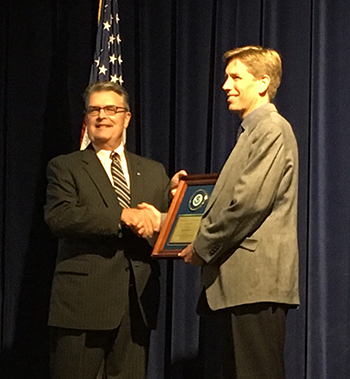2017 News & Events
CSD Receives OAR Outstanding Scientific Paper Award
9 June 2017

OAR restarted the Outstanding Scientific Paper Award this year after a few off-line years with only 5 of 25 nominated papers receiving an award. Our selected paper presents the chemical mechanism underlying the large wintertime ozone increases observed in the Utah Uintah Basin oil and gas region. It is a tour de force showcasing our skills in instrumentation, measurement strategy, the interpretation of atmospheric chemical observations, and working with stakeholders to diagnose and describe a complex and unexpected chemical phenomenon. Success in reaching this understanding required a multi-year effort by the large author group. Pete Edwards, a former CIRES scientist at CSD, is the first author and currently at the University of York. Steve Brown will accept the award and speak about the paper at the OAR awards ceremony on June 16 at the NOAA Auditorium in Silver Spring.
The nomination stated "This study solved the enigma of exceptionally high wintertime ozone concentrations discovered in a sparsely populated Western oil and gas production region, one suffering from an air quality problem previously associated only with summertime densely populated urban areas. The innovation in this study is that the author team recognized the salient features of the problem, identified the approach needed to resolve it, partnered with stakeholders and industry to carry out the necessary measurements, and persevered over three years of remote wintertime field work to collect critical data to fully characterize these episodes. The authors used their targeted chemical and meteorological measurements and a sophisticated atmospheric model to show definitively that this wintertime ozone came from the combination of large oil and gas emissions reacting for days at a time in a meteorologically-isolated basin, with snow on the ground acting to accelerate the chemical reactions leading to ozone formation. This study lays to rest more exotic and conjectural explanations for high ozone concentrations, and further has led to a predictive understanding not available previously that has been used by the Utah Department of Environmental Quality to draft effective and scientifically sound emissions control measures."
Due to the increase in new extraction technologies, the United States is now seeing the fastest expansion of oil and gas production in four decades. Chemicals released into the air by oil and gas exploration, extraction, and related activities can trigger reactions that lead to high levels of ozone in wintertime – levels high enough to exceed federal health standards. What causes these observed high levels of ozone concentrations in western oil and gas production regions during winter has until now remained a mystery.
This study provided a quantitative assessment of the photochemistry that leads to extreme winter ozone pollution events, and it identified key factors that control ozone production in this unique environment. These data, along with the close collaboration with stakeholders, allowed the researchers to better understand the effect of gas and oil production on winter ozone levels, which in turn can be used to inform policy decisions that address ozone pollution levels.
The research exemplifies CSD's core mission of obtaining a scientific understanding of the ozone layer in order to make optimal decisions at this moment and for generations to come, and supports NOAA's mission to predict changes in climate and share that knowledge with others.
Edwards, P.M., S.S. Brown, J.M. Roberts, R. Ahmadov, R. Banta, J. de Gouw, W.P. Dube, R.A. Field, J. Flynn, J. Gilman, M. Graus, D. Helmig, A. Koss, A.O. Langford, B. Lefer, B. Lerner, R. Li, S.-M. Li, S. McKeen, S. Murphy, D. Parrish, C.J. Senff, J. Soltis, J. Stutz, C. Sweeney, C. Thompson, M.K. Trainer, C. Tsai, P. Veres, R.A. Washenfelder, C. Warneke, R.J. Wild, C.J. Young, B. Yuan, and R. Zamora, High winter ozone pollution from carbonyl photolysis in an oil and gas basin, Nature, doi:10.1038/nature13767, 2014.
Abstract
The United States is now experiencing the most rapid expansion in oil and gas production in four decades, owing in large part to implementation of new extraction technologies such as horizontal drilling combined with hydraulic fracturing. The environmental impacts of this development, from its effect on water quality to the influence of increased methane leakage on climate, have been a matter of intense debate. Air quality impacts are associated with emissions of nitrogen oxides (NOx = NO + NO2) and volatile organic compounds (VOCs), whose photochemistry leads to production of ozone, a secondary pollutant with negative health effects. Recent observations in oil- and gas-producing basins in the western United States have identified ozone mixing ratios well in excess of present air quality standards, but only during winter. Understanding winter ozone production in these regions is scientifically challenging. It occurs during cold periods of snow cover when meteorological inversions concentrate air pollutants from oil and gas activities, but when solar irradiance and absolute humidity, which are both required to initiate conventional photochemistry essential for ozone production, are at a minimum. Here, using data from a remote location in the oil and gas basin of northeastern Utah and a box model, we provide a quantitative assessment of the photochemistry that leads to these extreme winter ozone pollution events, and identify key factors that control ozone production in this unique environment. We find that ozone production occurs at lower NOx and much larger VOC concentrations than does its summertime urban counterpart, leading to carbonyl (oxygenated VOCs with a C = O moiety) photolysis as a dominant oxidant source. Extreme VOC concentrations optimize the ozone production efficiency of NOx. There is considerable potential for global growth in oil and gas extraction from shale. This analysis could help inform strategies to monitor and mitigate air quality impacts and provide broader insight into the response of winter ozone to primary pollutants.